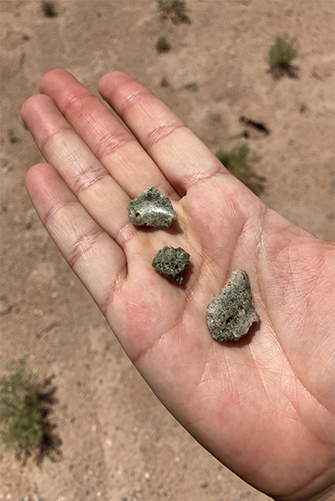Biostatistics student explored COVID-19, health disparities at Oppenheimer lab
Micaela Richter interned with a data analytics group at Los Alamos National Laboratory
By Kristen Mitchell

Walking through a New Mexico desert, Micaela Richter couldn’t see anything but blue sky for miles. If you were going to conduct secret nuclear bomb testing, she thought, this would be the place to do it.
Richter is a fourth-year biostatistics PhD student at the College of Public Health and spent her summer interning with a data analytics group at Los Alamos National Laboratory. If the middle-of-nowhere lab sounds familiar, it’s likely because it served as a backdrop for the summer blockbuster “Oppenheimer,” named for J. Robert Oppenheimer, who once directed the lab and oversaw the detonation of the world’s first nuclear weapon in 1945.
“We took a field trip to the Trinity Site where they did the test,” Richter said. “There’s still little fragments of that material that was created there. It was crazy to be able to pick it up and look at it.”

There was plenty of buzz about the movie in Los Alamos — population 12,978. Many of the town’s residents are affiliated with the lab and some even acted as extras in the film, Richter said. While there is no movie theater in town, the lab screened the film multiple times a day and hosted talks throughout the summer about Oppenheimer and the lab’s history.
Richter attended a screening with fellow interns and recognized a few filming locations, she said.
“There was a lot of hype about it,” she said. “It was pretty fun.”
While it was an interesting time in pop culture history to be spending her summer at Los Alamos, Richter was also hard at work on research with important implications for public health.
She used a complex model developed at the lab to identify potential drivers of health disparities related to COVID-19. Using the model to simulate human behavior, she looked at how people with varying racial and ethnic identities would interact with each other and the environment as an epidemic progressed, and used her findings to make inferences about the COVID-19 pandemic. She looked at links between disparities and health behaviors such as mask wearing, vaccination status and trust in the medical system.
Richter capped off her summer experience in August by presenting her research at the Los Alamos National Laboratory 2023 Student Symposium, where she received an award for her outstanding poster and presentation.
Now, she will continue using simulation data she collected at Los Alamos in an epidemic model developed by CPH researchers to understand how various state-level public health decisions might impact COVID-19 transmission during the height of the pandemic.
Grzegorz Rempala, professor of biostatistics, said Richter’s work has the potential to be a “really good scientific contribution to the field, not just a good dissertation.”
“These are very computationally costly approaches, and sometimes it’s impossible to make quick, accurate predictions based on information that is rapidly changing,” Rempala said. “She’s been working on methods that allow you to dramatically speed up these kinds of simulations — some ways to take computational shortcuts that are based on more up-to-date information and therefore is more accurate.”
Associate Professor Eben Kenah, who interned at Los Alamos as a graduate student in 2007, described Richter as a tenacious problem solver.
“She doesn’t give up easily on solving a problem and that’s really important,” he said. “Micaela has a lot of ability, but she also works hard, and you need both. She’s been a fantastic student to work with.”
Rempala and Kenah said they are hopeful more CPH students will be able to intern at the Los Alamos lab in the future.
Richter majored in applied mathematics at Case Western Reserve University, where she also pursued minors in music and public health. She discovered her interest in biostatistics during a gap year summer program at the University of Iowa, and decided she wanted to build on her public health education and use her math background to help others.
Richter’s passion for research stems from her desire to collaborate with people who have interesting ideas and different points of view, she said.
“I really like learning — new ideas, new topics, and when you’re researching, you never really stop learning,” she said. “Especially in biostatistics.”